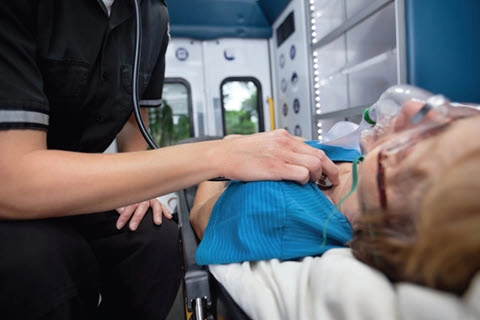MDS Alert
Designate Certain Roles In Case Gun Violence Touches Your Facility
Train employees on what to do in the immediate and lasting aftermath.
If your facility ever experiences an active shooter situation, your facility will also experience the aftermath of an active shooter situation.
“As we have said repeatedly since declaring gun violence a public health crisis in 2016, gun violence is out of control in the United States, and, without real-world, common-sense federal actions, it will not abate,” said Gerald E. Harmon, MD, president of the American Medical Association (AMA), in response to the recent Tulsa hospital shooting.
Here’s what several federal agencies — U.S. Departments of Health and Human Services (HHS), Homeland Security, Department of Justice (DOJ), FBI, FEMA — recommend healthcare facilities plan and execute in the moments and days after gun violence happens in a facility.

Prepare for Designated Assessments and Accounting
Important: “It is important to note that once the active shooter is apprehended or incapacitated, the situation and the location will be an active crime scene. Nothing should be touched unless it involves tending to the wounded,” the federal agencies say.
If your facility is a place designated to accept victims as patients in a mass casualty event, plan for an influx of people and emergent needs.
Once an active shooter is no longer a threat, human resources (HR) or a person in management should start accounting for the people known to be in the facility at the time.
This includes residents, staff, vendors, volunteers, and visitors. (This kind of scenario is a good reason for your facility to have stringent protocols around staff clocking in and volunteers and visitors signing in.)
The person in charge of this accounting should be counting people, noting whether anyone is injured or missing, and then coordinating with first responders to account for anyone who wasn’t evacuated.
The federal agencies note that it would probably be up to HR or a manager or administrator to contact the families of anyone affected (missing, injured, killed), but that this should be done in coordination with law enforcement. Communication should be a top priority in both preparedness planning and execution.
There should be a safe space available for employees, residents, and visitors to reunite or unite with their families (or where families can wait for information), which should be communicated to employees, residents, and visitors without the pressure or presence of the press.
“Within an ongoing and/or evolving emergency, where the immediate reunification of loved ones is not possible, providing family members with timely, accurate, accessible, and relevant information is paramount. The local or regional mass fatality plan may call for the establishment of a family assistance center to help family members locate their loved ones and determine whether or not they are among the casualties. This center should be placed away from media view or exposure,” the federal agencies say.
If your facility includes a daycare or other organization where minors may regularly be present, make sure you include a child release process to ensure that any children involved are released only to authorized people, the agencies note.
Answer These Questions, Complete These Activities
Once the initial accounting has been performed, a designated staff member should have information available for victims to access resources like distress helplines, counselors, and employee assistance, as well as platforms for recovery support. Facilities should plan in advance to make sure all of these resources are accessible to those who are blind, have low vision, deaf, hard of hearing, low literacy, or other communication disabilities, as well as individuals who may not speak or read English proficiently.
Make sure there are backups for all of these responsibilities or other organizational gaps in case any of the people designated to fulfill these duties are hurt or killed by the active shooter. Organizations should also know who will be responsible for determining if, how, and when full services will resume.
Besides the immediate actions of tending to the wounded and not touching anything that would affect the facility as a crime scene, it’s important to have a plan in place that emphasizes that an affected facility will be subject to an extended and evolving investigation. This is part of the continuity and succession planning that should already be part of your general and specific emergency preparedness plan and response.

Various industry stakeholders and professional organizations have information on how to best organize and implement emergency preparedness plans, but one question you might start with is: Will the facility evacuate residents somewhere else until an investigation is completed? If so, make sure you have answers for these additional questions (among others):
- who will go where;
- when will evacuation occur;
- who will communicate the decision to residents and their representatives, and how;
- who will help residents during and after the transition; and
- who will manage the transport (physical, virtual, or otherwise) of important medical records and assessments?
The federal agencies note that part of your planning should include training personnel to provide assistance to victims, witnesses, and their families, including an incident response team (which includes first responders). These are the folks who should be able to assess and triage victims immediately and help throughout the recovery, eventually integrating with local or state or federal resources and response teams.
Be Prepared to Offer Psychological First Aid
Find out more about how to support staff, residents, and other affected people, including providing “psychological first aid” in the next issue of MDS Alert.
MDS Alert
- Emergency Preparedness:
Designate Certain Roles In Case Gun Violence Touches Your Facility
Train employees on what to do in the immediate and lasting aftermath. If your facility [...] - Staffing:
Consider This Recent Court Ruling When Hiring
Hint: Put policies in place before you ‘need’ them. According to a recent survey released [...] - ICD-10 Coding:
Be Prepared to Code Falls Before Autumn Hits
Remember: Updated ICD-10 codes go into effect annually Oct. 1. The World Health Organization (WHO) [...] - COVID-19:
DNS Pleads Guilty to Forging Vaccination Cards
The DNS may face 5 years in federal prison for the offense. The feds continue [...] - Reader Questions:
Don’t Count Teeth as Bones After Fall
Question: If a resident falls and breaks a tooth, does that count as a fracture when [...] - Reader Questions:
Death is ‘in Facility’ Unless Resident Formally Discharged
Question: If a resident dies while being transported to the hospital, does the death count as [...] - Reader Questions:
Look to This Z-Code for Post-Amputation Stays
Question: What’s the best ICD-10-CM code to describe a resident who’s admitted after having a limb [...]

